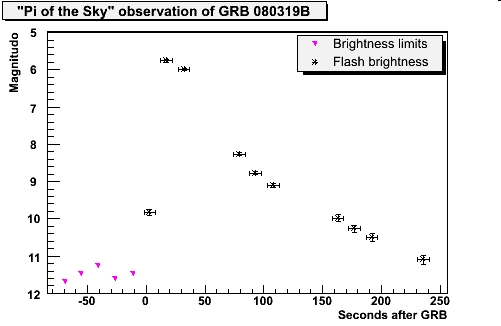March 19,2008 marked the brightest ever cosmic explosion observed from Earth ( see Georg von Hippel's article here and the news article here). The outburst denoted as GRB 080319B was probably the death of a massive star leading to the creation of a black hole.
For the first time the birth of a black hole has been filmed. Cameras of the "Pi of the Sky" project recorded this remarkable event with a 4 minutes sequence of 10-second images. In under 20 seconds the object became so bright that it was visible with the naked eye. Then it began fading and in 4 minutes was 100 times fainter. At that time the observation was taken over by larger telescopes.

The "Pi of the Sky" observation combined with the Swift satellite gamma-ray data confirmed for the first time with 10 second precision that optical emission starts simultaneously with the gamma-ray burst. Optical observations during the first seconds of the burst are crucial to understand the mechanism of releasing such huge amounts of energy.
This observation was affirmation of the "Pi of the Sky" project. Usually, optical emission from gamma ray bursts is observed by telescopes listening to alerts from satellite gamma ray detectors. Signal distribution and turning the telescope take some time and the very first minute of the outburst cannot be observed. The principles of the "Pi of the Sky" project are different.
The apparatus monitors continuously large fraction of the sky taking 10s exposures and detects optical flashes independently, while the satellite information confirms the origin of the flash.
Currently "Pi of the Sky" apparatus consists of two cameras installed in Las Campanas Observatory. They cover 20x20 degree of the sky. To increase the chance of observing a GRB 32 new cameras are under construction. They will cover 1/3 of the visible sky continuously. Original plan was to cover pi (~3.14) steradians of the sky, giving the name for the project. The name recalls also the title of John Barrow book "Pi in the sky" arguing that the phenomena we observe are governed by physical laws expressed in mathematical language.

The “Pi of the Sky” project was inspired by Bohdan Paczynski, great astrophysicist who died last year. He contributed much to the understanding of gamma ray bursts and always believed that small telescopes have large potential for sky surveys.
The project is conducted by collaboration of Polish research institutes: Soltan Institute for Nuclear Studies (Warsaw), Center for Theoretical Physics PAS (Warsaw), Warsaw University, Warsaw University of Technology, Space Research Center PAS (Warsaw), University of Cardinal Stefan Wyszynski (Warsaw), Pedagogical University of Cracow.






Comments